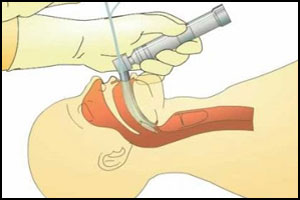- Home
- Editorial
- News
- Practice Guidelines
- Anesthesiology Guidelines
- Cancer Guidelines
- Cardiac Sciences Guidelines
- Critical Care Guidelines
- Dentistry Guidelines
- Dermatology Guidelines
- Diabetes and Endo Guidelines
- Diagnostics Guidelines
- ENT Guidelines
- Featured Practice Guidelines
- Gastroenterology Guidelines
- Geriatrics Guidelines
- Medicine Guidelines
- Nephrology Guidelines
- Neurosciences Guidelines
- Obs and Gynae Guidelines
- Ophthalmology Guidelines
- Orthopaedics Guidelines
- Paediatrics Guidelines
- Psychiatry Guidelines
- Pulmonology Guidelines
- Radiology Guidelines
- Surgery Guidelines
- Urology Guidelines
Non supine positioning not linked with higher success rate in ED intubation

The supine position (SP) is the preferred position for emergency department (ED) patients undergoing orotracheal intubation. However, for obese patients or in patients with a suspected difficult airway, ED providers are more likely to use non‐supine (NSP) positioning. Now, a recent study published in the journal Academic Emergency Medicine has found that NSP is associated with more adverse events but there are no differences in the first‐pass success of the two groups.
Intubation or tracheal intubation is the insertion of a flexible plastic tube (called an endotracheal tube) into the windpipe (trachea) to allow administration of certain drugs through an open airway.
Head‐up positioning for preoxygenation and ramping for morbidly obese patients are well-accepted techniques, but the effect of head‐up positioning with full torso elevation for all intubations is controversial. H. Hill Stoecklein, Division of Emergency Medicine, University of Utah, Salt Lake City, UT, USA, and colleagues compared first‐pass success, adverse events, and glottic view between supine (SP) and non‐supine (NSP) positioning for ED patients undergoing orotracheal intubation.
The researchers conducted a retrospective analysis of prospectively collected data on medically indicated, non-trauma-related intubations in National Emergency Airway Registry (NEAR; n=11,480). They analyzed outcomes in patients with supine vs nonsupine (upright or ramped) positioning. Of 11,480 total intubations, 5.8% were performed in NSP. The NSP group included significantly more obese patients and patients with a suspected difficult airway.
The primary outcome was first‐attempt intubation success and secondary outcomes were glottic views and peri‐intubation adverse events.
They found that:
- First‐pass success and the overall rate of grade I glottic views were similar between groups while NSP had a significantly higher rate of grade I view when direct laryngoscopy was employed.
- NSP was associated with higher odds of any adverse event.
"A randomized trial comparing patient positioning during intubation in the ED is warranted," concluded the authors.
For detailed study log on to https://doi.org/10.1111/acem.13805

Disclaimer: This site is primarily intended for healthcare professionals. Any content/information on this website does not replace the advice of medical and/or health professionals and should not be construed as medical/diagnostic advice/endorsement or prescription. Use of this site is subject to our terms of use, privacy policy, advertisement policy. © 2020 Minerva Medical Treatment Pvt Ltd